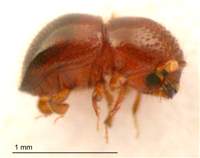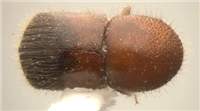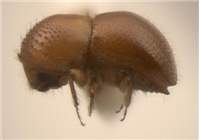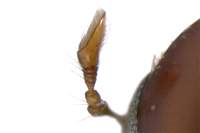Diagnosis
Bulky to extremely stout species, reddish to black. Main character: procoxae separated, sometimes only narrowly. Pronotal base with a faint tuft of mycangial setae. Antennal club flat, type 1. Elytral declivity usually steep, often obliquely truncated.
Similar to Anisandrus, but procoxae separated.
Distribution
Global distribution, common in temperate as well as tropical regions. In North America, the recently invaded X. germanus and X. crassiusculus are becoming the most common ambrosia beetle species.
Biology
Most species colonize small branches or twigs. Several species have gained economic importance after their introduction to continents. For example, Xylosandrus germanus, X. compactus and X. classiusculus are causing significant damage to North American orchards by attacking life fruit trees.
Taxonomy
Recently revised by Dole et al. (2010). Possibly polyphyletic, very few characters shared besides discontiguous procoxae.
Detailed description
Eyes shallowly or deeply emarginate, upper part smaller than lower part. Antennal club approximately circular, rarely taller than wide, flat. Club type one (truncated, segment 1 covering posterior side), type 4 in X. mixtus. Segment 1 of club circular around club, covering entire posterior face, margin of segment 1 costate. Segment 2 narrow, pubescent, visible on anterior side only. Segment 3 absent from posterior side of club. Segment 1 of antennal funicle shorter than pedicel, funicle 4-segmented, scapus regularly thick, or appears long and slender. Frons above epistoma mostly smooth, alutaceous, with minor punctures, or rugged, coarsely punctate. Submentum shaped as very narrow triangle, slightly impressed, or deeply impressed in small species, impression sometimes surrounded with costate edge or carina. Anterior edge of pronotum with distinct row of serrations. Pronotum from lateral view low and rounded (type 1), or tall (type 2), or rounded and robust (type 5), from dorsal view rounded (type 1). Pronotal disc shining or smoothly alutaceous, with small punctures, lateral edge of pronotum obliquely costate. Procoxae narrowly to widely separated, anterocoxal and posterocoxal prosternal processes merged into a process of variable shape, from short and conical, or flat and inconspicuous, or tall and pointed. Base of pronotum with small tuft of setae associated with mesonotal mycangium (sometimes very faint). No elytral mycangium and no setae associated with it on elytral bases. Scutellum flat, flush with elytra. Elytral bases straight, with oblique edge, elytral disc longer or shorter than declivity, slightly to distinctly convex, punctures on elytral disc in strial lines (difficult to discern in some montane species). Lateral profile of elytral declivity slightly convex and gradually sloped to steep, especially towards apex, to obliquely truncated; dorsal profile of elytral apex rounded, or truncated, or rounded and broadened laterally. Posterolateral declivital costa ending in 7th interstriae. Elytral declivity without armature, usually smooth or granulate-punctate (upper part of declivity in some SE Asian species with ridges and furrows). First interstriae parallel. Protibiae very slender, slightly broader only at distal end. Posterior side of protibia flat, no granules, only setae. Protibial denticles mostly large, distinctly longer than wide, bases of denticles usually distinctly enlarged and almost conical, in most species fewer than 6 protibial denticles present. Body length varies greatly, from minute and very short, almost globular species to large montane species (1.3-4.2 mm.). Moderately to densely hairy. Uniformly light brown to dark brown to black, or pronotum dark, but elytra white semitransparent with a whitish patch.





